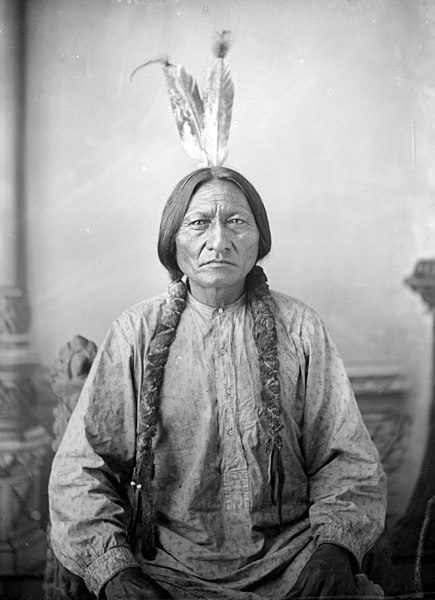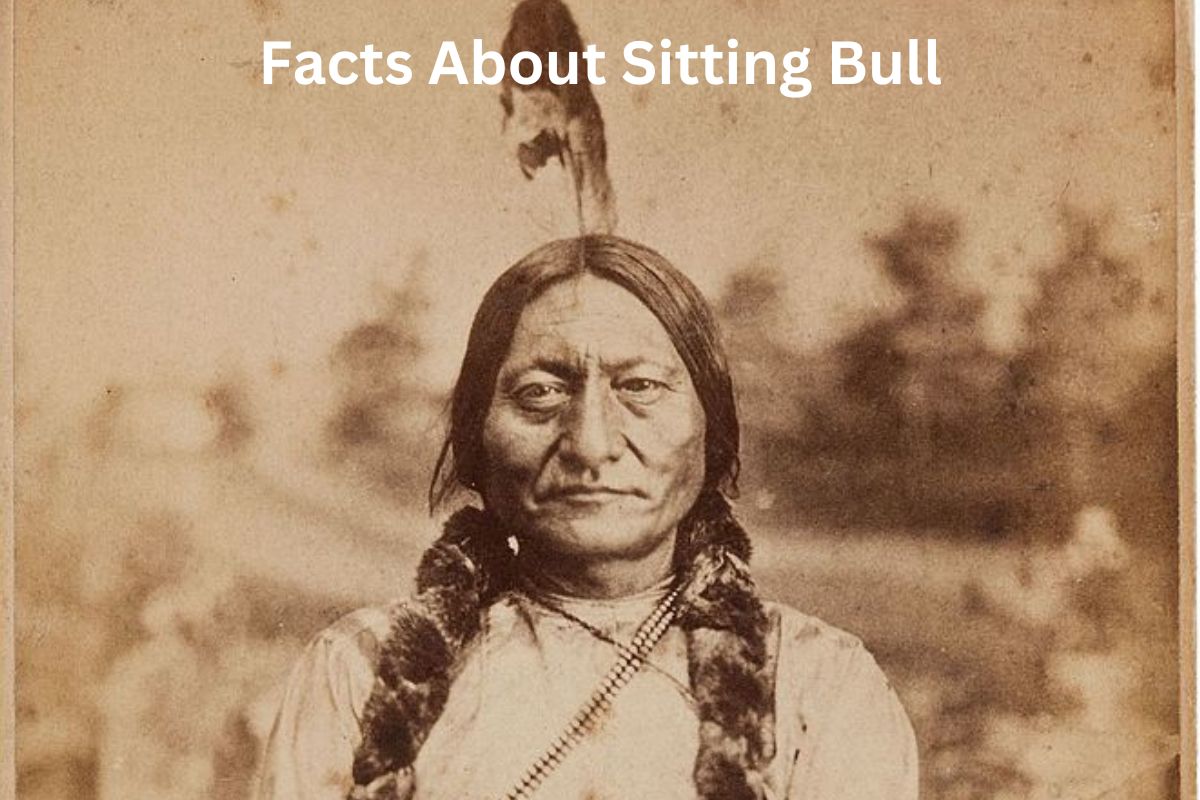Sitting Bull, also known by his Lakota name Tatanka Iyotake, was a Hunkpapa Lakota Sioux chief, holy man, and visionary leader.
Born in 1831 near present-day Grand River in South Dakota, he rose to prominence for his role in the Battle of Little Bighorn in 1876, where he played a crucial part in the defeat of Lieutenant Colonel George Armstrong Custer and his Seventh Cavalry.
Sitting Bull was a staunch advocate for Lakota sovereignty, cultural preservation, and resistance against the encroachment of white settlers. His spiritual abilities and participation in significant Lakota religious ceremonies, such as the Sun Dance, further solidified his influence among his people.
While he briefly joined Buffalo Bill Cody’s Wild West Show, he ultimately left due to his dissatisfaction with the exploitation of Native American culture.
Tragically, Sitting Bull was killed in 1890 during a confrontation with Indian police, leaving behind a legacy of leadership, spirituality, and unwavering commitment to the rights and well-being of the Lakota Sioux people.
Sitting Bull Facts
1. Sitting Bull was born in 1831 near present-day Grand River in South Dakota
Sitting Bull, whose Lakota name was Tatanka Iyotake, was born in 1831 near present-day Grand River in South Dakota.
Also Read: Sioux Tribe Facts
He was a member of the Hunkpapa Lakota Sioux tribe, which was part of the larger Sioux Nation. The exact date of his birth is not known with certainty, as Lakota people did not traditionally keep written records.

2. Sitting Bull is best known for his leadership during the Battle of Little Bighorn in 1876
Sitting Bull’s most famous moment in history came during the Battle of Little Bighorn in 1876. The battle took place in Montana Territory, and Sitting Bull, along with other Lakota, Northern Cheyenne, and Arapaho warriors, led a united front against the U.S. Army’s Seventh Cavalry, commanded by Lieutenant Colonel George Armstrong Custer.
Also Read: Crazy Horse Facts
The battle resulted in a significant victory for the Native American forces, who managed to defeat and kill Custer and his entire battalion.
3. He was a visionary leader who foresaw the encroachment of white settlers on Native American lands
Sitting Bull was a visionary leader who recognized the threats posed by the encroachment of white settlers on Native American lands. He was deeply committed to protecting the rights and culture of his people.
Also Read: Facts About the Apache Tribe
Sitting Bull vehemently opposed the signing of the Fort Laramie Treaty of 1868, which established the Great Sioux Reservation. He believed that the treaty undermined Lakota sovereignty and rights to traditional hunting grounds.
Sitting Bull’s opposition to the treaty led to tensions with the U.S. government and further fueled his reputation as a resistance leader.
Sitting Bull’s leadership and vision extended beyond the Battle of Little Bighorn and the resistance against the U.S. government. He played a crucial role in promoting Lakota unity and cultural preservation, becoming an influential figure among the Lakota and other Native American tribes.
His legacy as a fearless leader and advocate for Native American rights continues to inspire and resonate with people today.
4. Sitting Bull was a prominent advocate for Lakota sovereignty and cultural preservation
Sitting Bull was a staunch advocate for Lakota sovereignty and cultural preservation. He deeply valued the traditional way of life of his people and resisted assimilation into white American culture.
Sitting Bull opposed the provisions of the Fort Laramie Treaty of 1868 because he believed it infringed upon Lakota hunting rights and restricted their freedom to roam and live according to their traditions.
He refused to sign the treaty and instead continued to assert Lakota sovereignty and the right to protect their ancestral lands.
5. In 1875, Sitting Bull led his people to Canada, seeking refuge from the increasing U.S. military pressure
In 1875, as tensions between the Lakota and the U.S. government continued to rise, Sitting Bull led his people to Canada. He sought refuge there, hoping to escape the increasing military pressure and maintain the Lakota way of life.
Sitting Bull and his followers stayed in Canada for four years, living near Wood Mountain in present-day Saskatchewan. During their time in Canada, they formed alliances with other Indigenous groups, including the Cree and the Assiniboine.
6. Sitting Bull was known for his spiritual and healing abilities
Sitting Bull was not only a political and military leader but also a spiritual figure and healer. He was highly regarded for his spiritual abilities and was recognized as a powerful medicine man among his people.
Sitting Bull was known to have profound visions and was seen as a conduit between the spiritual and physical worlds. He played a significant role in Lakota religious ceremonies, particularly the Sun Dance.
Sitting Bull’s participation in the Sun Dance not only demonstrated his spiritual connection but also served to inspire and unify his people in times of adversity.
7. He actively participated in the Sun Dance, a significant Lakota religious ceremony
Sitting Bull actively participated in the Sun Dance, a significant religious ceremony in Lakota culture. The Sun Dance was a communal ritual that involved fasting, prayer, and various physical and spiritual tests.
Sitting Bull’s involvement in the Sun Dance not only showcased his personal spiritual beliefs but also reinforced his position as a spiritual leader among the Lakota people. Through his participation, he sought to connect with the divine and provide guidance and inspiration to his community.
8. Sitting Bull toured with Buffalo Bill Cody’s Wild West Show for a brief period in 1885
In 1885, Sitting Bull briefly joined Buffalo Bill Cody’s Wild West Show. He saw this as an opportunity to raise awareness about the struggles and injustices faced by Native Americans while also earning much-needed income for his people.
Sitting Bull’s participation in the show attracted significant attention, and he became a popular attraction due to his reputation as a renowned Native American chief and spiritual leader.
However, Sitting Bull grew disillusioned with the commercial exploitation of his people’s culture and eventually left the show, feeling that it undermined the dignity and authenticity of Native American traditions.
9. Sitting Bull was arrested in 1890 by Indian police during the Ghost Dance movement
Sitting Bull’s arrest in 1890 marked a turning point in his life and had significant consequences for his people. The arrest occurred during the height of the Ghost Dance movement, which was a spiritual revitalization movement among various Native American tribes.
The U.S. government viewed the Ghost Dance as a potential uprising and aimed to suppress it. Sitting Bull was arrested by Indian police on charges of fostering rebellion.
His arrest sparked outrage among his followers and heightened tensions between Native American communities and the U.S. government.
10. On December 15, 1890, Sitting Bull was killed during a confrontation with Indian police sent to arrest him
Tragically, on December 15, 1890, Sitting Bull was killed during a confrontation between his supporters and Indian police at the Standing Rock Indian Reservation in present-day South Dakota.
The confrontation erupted when Indian police arrived to arrest Sitting Bull. A gunfight ensued, resulting in the death of Sitting Bull and several others.
His death further deepened the divide between Native American tribes and the U.S. government, and it became a symbol of resistance and martyrdom in the struggle for Native American rights and autonomy.
